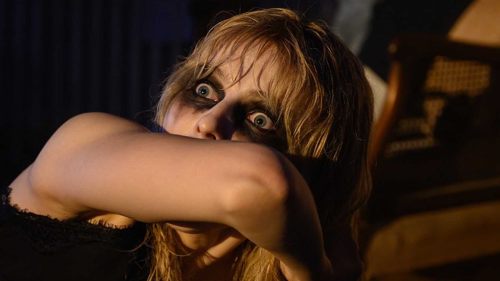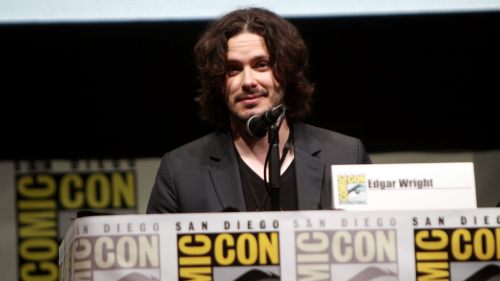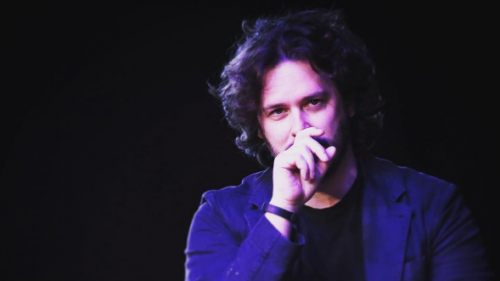Edgar Wright Talks BABY DRIVER And The Enduring Legacy Of Walter Hill
Baby Driver is out! Get your tickets here!
Edgar Wright’s one of our greatest working directors – a guy who’s minted at least three modern masterpieces, including his latest: the action musical, Baby Driver. Some will say we’re overhyping it, but Baby Driver is easily this author’s favorite film of ‘17 thus far. A hyperactive mix of heist movie madness and experimental pop chaos, it’s the most thrilling amalgamation of music and the moving image since Walter Hill’s Streets of Fire (’84). Speaking of Hill, Wright knowingly cribs from the curmudgeonly genre master, shooting the film’s mind-blowing car stunts practically, and setting the narrative inside a hyper-stylized world of diners, back alley boardrooms, and warehouse shoot outs. Another time, another place, indeed.
We had the privilege to sit down with Wright to discuss Baby Driver, and what followed was a fun, polite chat about a picture that’d been brewing in his head for two decades, and his lifelong affection for rubber-burning spectacle…
BMD: At SXSW, you introduced the movie and said it’d been living with you for twenty-plus years…
Edgar Wright: Twenty-two. That’s right.
BMD: I was wondering – what was the initial song that sparked Baby Driver? What were you listening to?
EW: Well, when I say this movie’s been with me for twenty-two years, it often gets translated as “Edgar Wright’s been trying to make this movie for twenty-two year.” No. Back up. Twenty-two years ago, I wasn’t even a film writer. [laughs] But I had already made my first movie at that point…
BMD: A Fistful of Fingers?
EW: Right. I made that when I was twenty, with no money at all. After that, I moved to London and was sleeping on my brother’s floor, before moving into a house with friends where I finally had my own room. I remember when I was there, I was trying to edit A Fistful of Fingers, and somebody had given me an audio cassette – not the original album, mind you, but a dubbed cassette, so apologies to Jon Spencer – of Orange by the Blues Explosion, and I just listened to “Bellbottoms” over and over again. Before I even knew it was a movie I had this thing in my head – one of these moments when you’re twenty, and you’re in London, and you’ve got no money, and the idea of Hollywood is a million miles away. You’re not thinking “this is a movie”, but I was visualizing this car chase. What I was imagining was basically the opening scene of [Baby Driver]. It’s not like I have synesthesia or anything, but it’s as close as I can get to that in terms of listening to a song and visualizing action.
That’s really how the movie came about, and the action became synonymous with the character [Ansel Elgort’s Baby – the lead getaway driver]. I share some similarities with [Baby], such as listening to music over and over again, obsessively. But also, like a lot of people, I want to have some sort of control over my life by sound-tracking my every day. A lot of people use music as a means of escape – like, for instance, if you work at a shit job, or you have to take a train and two buses during your daily commute, at least you have some control over what’s going on in your ears, you know? So, I like taking ideas like that and stretching them out to a dramatic extent. Another example – have you ever pulled up outside a Starbucks and just waited for the song you’re listening to in your car to end before going inside?
BMD: I actually did that before coming into this interview with Talking Heads’ “Life During Wartime”.
EW: A lot of people do that type of thing, only Baby’s taking that to the next level. He literally can’t function without music playing. But it wasn’t until I really started writing the script proper – I didn’t actually finish it until after Scott Pilgrim [vs. the World] in 2011 – that I started doing research with ex-cons and DJs, talking to both about their relationships to music. I’d ask getaway drivers whether they’d listen to any music while on a job, and I’d ask DJs how they’d put together the perfect playlist. I kept thinking about the movie in terms of pacing it like a musical, and having each scene shaped to the music.
I also remember reading Oliver Sacks’ book Musicolphilia, and there was some mention in there about tinnitus, which I had as a kid. When I read a bit more about that, and found out people used music to combat tinnitus and drown it out – including Barbara Streisand, which I made into a little joke in the movie – I thought “that’s it!” Music for Baby is not only his fuel, but also becomes his obsession, taking this element that can motivate you in a positive way, and turning it into a debilitating notion.
So, these were all ideas that were going on for a long time, and then I made a music video in 2002 for this bad called Mint Royale – it’s a blues song that appears very briefly in the movie – but it essentially operated as a dry run for the opening scene. If I’m going to be honest, though, it was never intended as a road test at the time; I just simply got to the night before I needed to hand in a treatment, and didn’t have any better ideas! [laughs] It starred Noel Fielding from The Mighty Boosh, and just kept popping up for the next ten years or so. Initially, I was annoyed with myself for wasting this idea for a movie on a music video, but it acted as a sort of amuse-bouche for Baby Driver. Now when people started going “is this just a rip off of Drive (’11)?” after the trailer came out, I say “well, let me refer you to my 2002 music video…not to mention Walter Hill’s The Driver.”
BMD: I hate the limited frame of reference so many film fans have today. They act like no car chase pictures existed before that fucking movie – which doesn’t even have any real good car chases!
EW: Well, you know Walter Hill’s movie is obviously a huge influence, and my movie would not exist without that movie. There are others like The Hot Rock (’72), because I always think about Rob Leibman’s getaway driver in that one. But it’s a testament to Walter’s movie that it could inspire works as disparate as Baby Driver and Drive…or even Reservoir Dogs (’92), you know? Here’s this cult classic, or gem, depending on which term you prefer, that Walter put into the back of his mind until recently. I think I’ve finally convinced him, through the two or three interviews I’ve done with him about [The Driver], that he is far, far too modest and that it’s a really great movie. I’ve made it my life’s work to convince Walter that he’s made one of my favorite movies.
BMD: And he’s made so many classic films that are just waiting to be rediscovered, like Streets of Fire.
EW: Oh my God, Streets of Fire. I always remember watching that movie as a teenager, and I loved it, but I hadn’t watched it since. So, I didn’t bring that one up with Walter as much as some of the other ones. But I just re-watched Streets of Fire recently – literally a couple weeks ago – and it was just as vivid as it was in my head.
BMD: It’s a mind-blower, right? One of the greatest ever made.
EW: I remembered it exactly how it was, and I actually thought that there were a lot of things in that movie that I’d taken on almost by osmosis, because I’d never re-watched it in all that time.
But anyway, let me tell you one little addendum to the Drive story I think you’ll find funny. I was at CinemaCon, and I know Ryan Gosling. We’re not super close or anything, but we have breakfast and dinner sometimes, and he’s a super nice guy. But he was aware of [Baby Driver] because some of the stunt team from Drive had worked on my movie.
We were both standing in the wings, waiting to present, because he was there to show off footage from Blade Runner 2049. He came up to me like, “I can’t wait to see your movie”, and I replied “well, you’re about to see five minutes of it right now.” All the sudden, I was really nervous like “oh God, I’m about to watch the first five minutes of Baby Driver with Ryan Gosling standing right next to me.” And God bless Ryan, because while he was watching it the first major Subaru car stunt where it goes around the corner and does a 370 [degree turn] happens, and he turns around and just [Edgar puts on his best Gosling tough guy mug and gives me a thumbs up].
BMD: You must’ve been so relieved. You got approved by the Driver!
EW: But wait! It gets better. After the presentation’s done, he comes over to me and goes “Subaru? I used to have a Subaru. What made you think of that?” And I told him that the stunt team told me it had to be that make and model because all the gear heads would go crazy over it. They were right.
BMD: There’s a thread about sampling that runs through the movie, and I was interested to pick your brain about that a little further – the way that Baby takes pieces of conversation and remixes them into songs. Are you commenting on how you’re taking pieces of films that you love and scrambling them into something your own? Plus, as you mentioned, it’s a way for him to even have control over these criminals he takes orders from.
EW: It’s interesting that you bring that up – while Baby is involved with crime, he’s fooling himself that it’s OK. In the opening twenty minutes of the movie, it’s a real “see no evil, hear no evil” proposition for him. But the idea with the songs is that they’re his way of dealing with the guilt of what he’s doing by mythologizing himself via these endless tapes that he makes of things happening around him.
I always like music with found sounds, and two people who worked on the movie inspired these sequences. One of them was this guy named Martin Nicholson, or Osymyso, who back in the day when mash-ups began, made this amazing song called “Intro-inspection”. It’s like fifteen minutes long, and just comprised of intros; astounding, really. And he’s done bits and bobs on my movies, right from Scott Pilgrim onwards. When I started making this movie and went to the studio with this script and all of the songs that were written into it, one of the things he did with me was that we made this mix of all the songs that had the sound effects mixed in. It would literally be like “Bellbottoms (Osymyso Mix)”; not anything that’s commercially available, but something we could show to the studio and say, “this is basically the idea behind the movie.” You could listen to the songs and hear the car chases happening, or “Tequila” would have the gunfight occurring around you. He’s credited on the movie as Sound Consultant, or something.
The second person who was integral in that stuff was Kid Koala, who wrote the two songs in the movie. So, the songs where Baby is kind of performing and doing cut up, found sound tunes that he’s making were done by Kid Koala. In fact, he came down to the set with his own equipment to show Ansel how to make music the same way he does. That magnetic strip that Baby runs his idea through is called a reader – it’s usually used to help kids learn how to read – and you can record your own voice and sounds and what have you, like sampling.
Without spoiling too much, when we hear the songs late in the movie, in front of Kevin Spacey and Jamie Foxx, it came to me in a later draft where I thought “usually in these thrillers, when somebody’s recording somebody else, it means they’re a narc.”
BMD: Or it’s like Jack Terry in Blow Out, where he’s reconstructing events.
EW: Yeah, and it was the idea that protecting his own innocence became the way to save him. I thought it’d be funny that these goofy songs he makes could become an organic plot point. Music quite literally saves Baby’s life.



